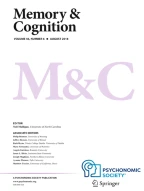Abstract
Emotion influences memory in many ways. For example, when a mood-dependent processing shift is operative, happy moods promote global processing and sad moods direct attention to local features of complex visual stimuli. We hypothesized that an emotional context associated with to-be-learned facial stimuli could preferentially promote global or local processing. At learning, faces with neutral expressions were paired with a narrative providing either a happy or a sad context. At test, faces were presented in an upright or inverted orientation, emphasizing configural or analytical processing, respectively. A recognition advantage was found for upright faces learned in happy contexts relative to those in sad contexts, whereas recognition was better for inverted faces learned in sad contexts than for those in happy contexts. We thus infer that a positive emotional context prompted more effective storage of holistic, configural, or global facial information, whereas a negative emotional context prompted relatively more effective storage of local or feature-based facial information
Article PDF
Similar content being viewed by others
Avoid common mistakes on your manuscript.
References
Adolphs, R., Gosselin, F., Buchanan, T. W., Tranel, D., Schyns, P., &Damasio, A. R. (2005). A mechanism for impaired fear recognition after amygdala damage.Nature,433, 68–72.
Barrett, L. F., Lindquist, K. A., &Gendron, M. (2007). Language as context for the perception of emotion.Trends in Cognitive Sciences,11, 327–332.
Canli, T., Zhao, Z., Brewer, J., Gabrieli, J. D., &Cahill, L. (2000). Event-related activation in the human amygdala associates with later memory for individual emotional experience.Journal of Neuroscience,20, 99–103.
D'Argembeau, A., &van der Linden, M. (2007). Facial expressions of emotion influence memory for facial identity in an automatic way.Emotion,7, 507–515.
D'Argembeau, A., van der Linden, M., Comblain, C., &Etienne, A.-M. (2003). The effects of happy and angry expressions on identity and expression memory for unfamiliar faces.Cognition & Emotion,17, 609–622.
Diamond, R., &Carey, S. (1986). Why faces are and are not special: An effect of expertise.Journal of Experimental Psychology: General,115, 107–117.
Fredrickson, B. L., &Branigan, C. (2005). Positive emotions broaden the scope of attention and thought-action repertoires.Cognition & Emotion,19, 313–332.
Gable, P. A., &Harmon-Jones, E. (2008). Approach-motivated positive affect reduces breadth of attention.Psychological Science,19, 476–482.
Gasper, K., &Clore, G. L. (2002). Attending to the big picture: Mood and global versus local processing of visual information.Psychological Science,13, 34–40.
Golby, A. J., Gabrieli, J. D., Chiao, J. Y., &Eberhardt, J. L. (2001). Differential responses in the fusiform region to same-race and otherrace faces.Nature Neuroscience,4, 845–850.
Jermann, F., van der Linden, M., &D'Argembeau, A. (2008). Identity recognition and happy and sad facial expression recall: Influence of depressive symptoms.Memory,16, 364–373.
Johnson, K. J., &Fredrickson, B. L. (2005). “We all look the same to me”: Positive emotions eliminate the own-race bias in face recognition.Psychological Science,16, 875–881.
Kensinger, E. A., Garoff-Eaton, R. J., &Schacter, D. L. (2007a). Effects of emotion on memory specificity in young and older adults.Journals of Gerontology: Psychological Sciences,62B, 208–215.
Kensinger, E. A., Garoff-Eaton, R. J., &Schacter, D. L. (2007b). Effects of emotion on memory specificity: Memory trade-offs elicited by negative visually arousing stimuli.Journal of Memory & Language,56, 575–591.
Kim, H., Somerville, L. H., Johnstone, T., Polis, S., Alexander, A. L., Shin, L. M., &Whalen, P. J. (2004). Contextual modulation of amygdala responsivity to surprised faces.Journal of Cognitive Neuroscience,16, 1730–1745.
Lundqvist, D., Flykt, A., & Ohman, A. (1998). The Karolinska directed emotional faces [CD-ROM]. Stockholm: Karolinska Institute, Psychology section, Department of Clinical Neuroscience.
Marian, D. E., & Shimamura, A. P. (2004).Effects of emotional facial expressions on memory for faces and associate expressions. Paper presented at the 10th Annual Meeting of the Cognitive Science Association for Interdisciplinary Learning, Hood River, OR.
Maurer, D., Le Grand, R. L., &Mondloch, C. J. (2002). The many faces of configural processing.Trends in Cognitive Sciences,6, 255–260.
Navon, D. (1977). Forest before trees: The precedence of global features in visual perception.Cognitive Psychology,9, 353–383.
Ochsner, K. N. (2000). Are affective events richly recollected or simply familiar? The experience and process of recognizing feelings past.Journal of Experimental Psychology: General,129, 242–261.
Payne, J. D., Stickgold, R., Swanberg, K., &Kensinger, E. A. (2008). Sleep preferentially enhances memory for emotional components of scenes.Psychological Science,19, 781–788.
Phelps, E. A. (2004). Human emotion and memory: Interactions of the amygdala and hippocampal complex.Current Opinion in Neurobiology,14, 198–202.
Ridout, N., Astell, A. J., Reid, I. C., Glen, T., &O'Carroll, R. E. (2003). Memory bias for emotional facial expressions in major depression.Cognition & Emotion,17, 101–122.
Rowe, G., Hirsh, J. B., &Anderson, A. K. (2007). Positive affect increases the breadth of attentional selection.Proceedings of the National Academy of Sciences,104, 383–388.
Shimamura, A. P., Ross, J. G., &Bennett, H. D. (2006). Memory for facial expressions: The power of a smile.Psychonomic Bulletin & Review,13, 217–222.
Snodgrass, J. G., &Corwin, J. (1988). Pragmatics of measuring recognition memory: Applications to dementia and amnesia.Journal of Experimental Psychology: General,117, 34–50.
Sweeny, T. D., Grabowecky, M., Suzuki, S., &Paller, K. A. (2009). Long-lasting effects of subliminal affective priming from facial expressions.Consciousness & Cognition,18, 929–938.
Tanaka, J. W., &Farah, M. J. (1993). Parts and wholes in face recognition.Quarterly Journal of Experimental Psychology,46A, 225–245.
Tyler, C. W., &Chen, C.-C. (2006). Spatial summation of face information.Journal of Vision,6 (10, Art. 11), 1117–1125. doi:10.1167/ 6.10.11
Valentine, T. (1988). Upside-down faces: A review of the effect of inversion upon face recognition.British Journal of Psychology,79, 471–491.
Yoon, K. L., &Zinbarg, R. E. (2008). Interpreting neutral faces as threatening is a default mode for socially anxious individuals.Journal of Abnormal Psychology,117, 680–685.
Author information
Authors and Affiliations
Corresponding author
Additional information
This work was supported by NSF Grants BCS-0518880 and BCS-0818912 to K.A.P. and NSF Grants BCS-0720312 and BCS-0722326 to J.Y.C.
Rights and permissions
About this article
Cite this article
Bridge, D.J., Chian, J.Y. & Paller, K.A. Emotional context at learning systematically biases memory for facial information. Memory & Cognition 38, 125–133 (2010). https://doi.org/10.3758/MC.38.2.125
Received:
Accepted:
Issue Date:
DOI: https://doi.org/10.3758/MC.38.2.125
